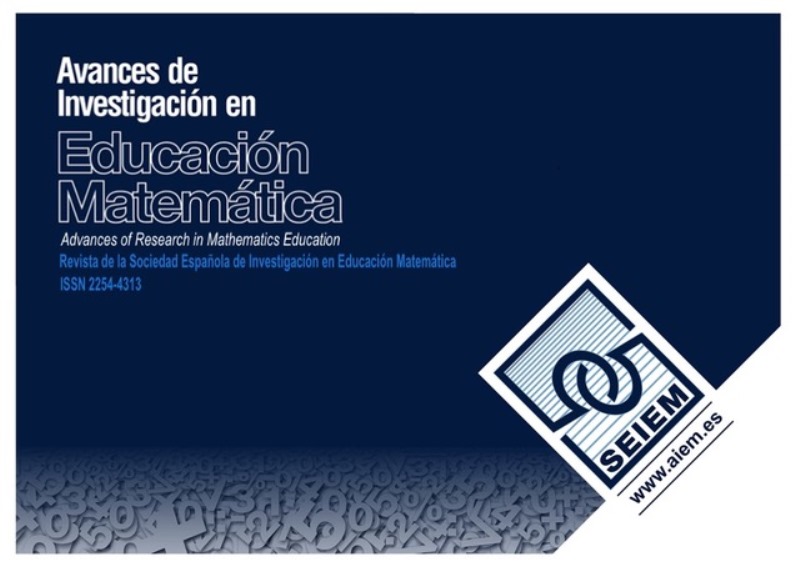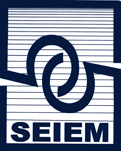Mathematical Connections Associated with the Vector Concept in a High School Textbook of the New Mexican School
DOI:
https://doi.org/10.35763/aiem25.6442Keywords:
Text analysis, Mathematical connections, Vector, Physics, MathematicsAbstract
Mathematics is a universe of connections between concepts, theorems, and procedures, they are even conceived as a feature of the discipline, not just internal connections but with some other. These connections play a fundamental role in concepts understanding; therefore, it is necessary to promote them in curricular materials. The goal of this paper is to analyze mathematical connections risen about the vector concept in the textbook “Saberes y Pensamiento Científico” of the high school education of the New Mexican School, based on three categories: unifying topics, mathematical procedures, and mathematical connectors. Mathematical connections are considered as relations between mathematical ideas, and they are one of the main features of mathematics. Methodologically, we use qualitative text analysis. Our results show that unifying topics, procedures, and mathematical connectors are understanding promoters, and they develop connections between conceptual and procedural knowledge of the vector concept.
Downloads
References
Alsina, A., & Coronata, C. (2014). Los procesos matemáticos en las prácticas docentes: diseño, construcción y validación de un instrumento de evaluación. Edma 0-6: Educación Matemática en la Infancia, 3(2), 23-36. https://doi.org/10.24197/edmain.2.2014.23-36
Barniol, P., & Zavala, G. (2014a). Evaluación del entendimiento de los estudiantes en la representación vectorial utilizando un test con opciones múltiples en español. Revista mexicana de física E, 60(2), 86-102.
Barniol, P., & Zavala, G. (2014b). Force, velocity, and work: The effects of different contexts on students’ understanding of vector concepts using isomorphic problems. Physical Review Special Topics-Physics Education Research, 10(2), 1-15. https://doi.org/10.1103/PhysRevSTPER.10.020115
Berisha, V., Thaçi, X., Jashari, H., & Klinaku, S. (2013). Assessment of mathematics textbooks potential in terms of student’s motivation and comprehension. Journal of Education and Practice, 4(28), 33-37.
Businskas, A. M. (2008). Conversations about connections: How secondary mathematics teachers conceptualize and contend with mathematical connections [Tesis Doctoral publicada]. Universidad Simon Fraser. https://bac-lac.on.worldcat.org/oclc/755208445
Carli, M., Lippiello, S., Pantano, O., Perona, M., & Tormen, G. (2020). Testing students ability to use derivatives, integrals, and vectors in a purely mathematical context and in a physical context. Physical Review Physics Education Research, 16(1). https://doi.org/10.1103/PhysRevPhysEducRes.16.010111
Coxford, A. F. (1995). The case for connections. In P. A. House & A. F. Coxford (Eds.), Connecting mathematics across the curriculum (pp. 3-12). National Council of Teachers of Mathematics.
Fan, L. (2013). Textbook research as scientific research: Towards a common ground on issues and methods of research on mathematics textbooks. ZDM–The International Journal on Mathematics Education, 45(5), 765-777. https://doi.org/10.1007/s11858-013-0530-6
Flores-García, S., Gonzalez-Quezada, M., & Herrera-Chew, A. (2007). Dificultades de entendimiento en el uso de vectores en cursos introductorios de mecánica. Revista Mexicana de Física E, 53(2), 178-185.
Gacovska-Barandovska, A., Celakoska-Jordanova, V., & Celakoska, E. (2020). Analyzing educational objectives that include critical thinking: Dot product problems in Vector Algebra. International Journal on Studies in Education, 2(2), 108-118. https://doi.org/10.46328/ijonse.16
García-García, J., Hernández-Yañez, M. E., & Rivera-López, M. I. (2022). Conexiones matemáticas promovidas en los planes y programas de estudio mexicanos de nivel secundaria y media superior sobre el concepto de ecuación cuadrática. IE Revista de Investigación Educativa de la REDIECH, 13. https://doi.org/10.33010/ie_rie_rediech.v13i0.1485
Hadar, L. L., & Ruby, T. L. (2019). Cognitive opportunities in textbooks: the cases of grade four and eight textbooks in Israel. Mathematical Thinking and Learning, 21(1), 54-77. https://doi.org/10.1080/10986065.2019.1564968
Haji, S., & Yumiati (2019). NCTM’s Principles and standards for developing conceptual understanding in Mathematics. Journal of Research in Mathematics Trends and Technology, 1(2), 56-65. https://doi.org/10.32734/jormtt.v1i2.2836
Harel, G. (2021). The learning and teaching of multivariable calculus: a DNR perspective. ZDM–Mathematics Education, 53(3), 709-721. https://doi.org/10.1007/s11858-021-01223-8
Heckler, A., & Scaife, T. (2015). Adding and subtracting vectors: The problem with the arrow representation. Physical Review Special Topics-Physics Education Research, 11(1), 1-17. https://doi.org/10.1103/PhysRevSTPER.11.010101
Knight, R. (1995). The vector knowledge of beginning physics students. The Physics Teacher, 33(2), 74-77. https://doi.org/10.1119/1.2344143
Kuckartz, U. (2019) Qualitative text analysis. A systematic approach. In G. Kaiser & N. Presmeg (Eds.), Compendium for early career researchers in mathematics education (pp. 181-197). Springer. https://doi.org/10.1007/978-3-030-15636-7
Latifa, B. R. A., Purwaningsih, E., & Sutopo, S. (2021). Identification of students’ difficulties in understanding of vector concepts using test of understanding of vector. Journal of Physics: Conference Series, 2098(1), 1-5. https://doi.org/10.1088/1742-6596/2098/1/012018
Mikula, B. D., & Heckler, A. F. (2017). Framework and implementation for improving physics essential skills via computer-based practice: Vector math. Physical Review Physics Education Research, 13(1), 1-23. https://doi.org/10.1103/PhysRevPhysEducRes.13.010122
National Council of Teachers of Mathematics [NCTM] (2000). Principles and standards for school mathematics. Autor.
Neuman, J., Hemmi, K., Ryve, A., & Wiberg, M. (2014, junio). Mathematics textbooks’ impact on classroom instruction: Examining the views of 278 Swedish teachers. Proceedings of the Seventh Nordic Conference on Mathematics Education, NORMA 14, 3-6 June 2014, Turku (Åbo), Finland.
Otero, M. R., Moreira, M. A., & Greca, I. M. (2002). El uso de imágenes en textos de física para la enseñanza secundaria y universitaria. Investigações em Ensino de Ciências, 7(2), 127-154.
Pincheira, N., & Alsina, Á. (2021). Explorando la demanda cognitiva de tareas matemáticas de búsqueda de patrones diseñadas por futuros profesores de Educación Primaria. En P. D. Diago, D. F. Yáñez, M. T. González-Astudillo & D. Carrillo (Eds.), Investigación en Educación Matemática XXIV (pp. 489-496). SEIEM.
Posner, G. (1998). Análisis de currículum (2da. Edición). McGraw-Hill Interamericana, S.A.
Rezat, S., & Strässer, R. (2014). Mathematics textbooks and how they are used. In P. Andrews, & T. Rowland (Eds.), Master class in mathematics education: International perspectives on teaching and learning (pp. 51-62). Bloomsbury. https://doi.org/10.5040/9781350284807.ch-005
Schubring, G., & Fan, L. (2018). Recent advances in mathematics textbook research and development: An overview. ZDM Mathematics Education, 50(5), 765-771. https://doi.org/10.1007/s11858-018-0979-4
Secretaría de Educación Pública [SEP] (2022). Avance del contenido del Programa sintético de la Fase 6. https://educacionbasica.sep.gob.mx/wp-content/uploads/2022/12/Avance-Programa-Sintetico-Fase-6.pdf
Secretaría de Educación Pública [SEP] (2023a). Plan de estudios para la educación preescolar, primaria y secundaria. https://educacionbasica.sep.gob.mx/wp-content/uploads/2023/07/Plan_de_Estudios_para_la_Educacion_Preescolar_Primaria_y_Secundaria.pdf
Secretaría de Educación Pública [SEP] (2023b). Saberes y pensamiento científico. Autor. https://www.conaliteg.sep.gob.mx/2023/S2SAA.htm#page/1
Shield, M., & Dole, S. (2013). Assessing the potential of mathematics textbooks to promote deep learning. Educational studies in mathematics, 82, 183-199. https://doi.org/10.1007/s10649-012-9415-9
Shodiqin, M., & Taqwa, M. (2021). Identification of student difficulties in understanding kinematics: focus of study on the topic of acceleration. Journal of Physics: Conference Series, 1918(2), pp. 1-5). https://doi.org/10.1088/1742-6596/1918/2/022016
Sierpinska, A., Dreyfus, T., & Hillel, J. (1999). Evaluation of a teaching design in linear algebra: the case of linear transformations. Recherches en Didactique des Mathématiques 19, (1), 7-40.
Sievert, H., van den Ham, A. K., Niedermeyer, I., & Heinze, A. (2019). Effects of mathematics textbooks on the development of primary school children’s adaptive expertise in arithmetic. Learning and Individual Differences, 74, 1-13. https://doi.org/10.1016/j.lindif.2019.02.006
Slisko, J. (2005). Errores en los libros de texto de física: ¿cuáles son y por qué persisten tanto tiempo? Sinéctica, Revista Electrónica de Educación, 27, 13-23.
Subsecretaría de Educación Media Superior [SEMS] (2023). La Nueva Escuela Mexicana (NEM): orientaciones para padres y comunidad en general. Autor.
Tairab, H., Al Arabi, K., Rabbani, L., & Hamad, S. (2020). Examining Grade 11 science students’ difficulties in learning about vector operations. Physics Education, 55(5). https://doi.org/10.1088/1361-6552/aba107
Toh, T. L., & Choy, B. H. (Eds.) (2021). Mathematics-Connection and Beyond. Yearbook 2020. Association of Mathematics Educators. World Scientific. https://doi.org/10.1142/12279
Weinberg, S. L. (2001). Is there a connection between fractions and division? Students’ inconsistent responses. Annual Meeting of the American Educational Research Association. https://files.eric.ed.gov/fulltext/ED456045.pdf
Downloads
Published
How to Cite
Issue
Section
License
Copyright (c) 2024 Flor Monserrat Rodríguez Vásquez, Viana Nallely García-Salmerón, Jesus Romero Valencia

This work is licensed under a Creative Commons Attribution 4.0 International License.
The articles published in this journal are under a license Creative Commons: By 4.0 España from number 21 (2022).
Authors who publish with this journal agree to the following terms:
- Authors retain copyright and keep the acknowledgement of authorship.
- The texts published in this journal are – unless indicated otherwise – covered by the Creative Commons Attribution 4.0 international licence. You may copy, distribute, transmit and adapt the work, provided you attribute it (authorship, journal name, publisher) in the manner specified by the author(s) or licensor(s). The full text of the licence can be consulted here: http://creativecommons.org/licenses/by-nc/4.0.
- Authors are able to enter into separate, additional contractual arrangements for the non-exclusive distribution of the journal's published version of the work (e.g., post it to an institutional repository or publish it in a book), with an acknowledgement of its initial publication in this journal.
- Authors are permitted and encouraged to post their work online (e.g., in institutional repositories or on their website) prior to and during the submission process, as it can lead to productive exchanges, as well as earlier and greater citation of published work (See The Effect of Open Access).









